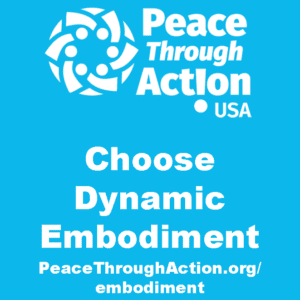What is Dynamic Embodiment™?
Dynamic Embodiment™ is a somatic (relating to the body) education and movement therapy that integrates skilled touch, movement, and compassionate dialogue to help people of all ages and abilities to relieve their own stress, find enhanced expressiveness, and balance all aspects of the body and mind. Dynamic Embodiment™ has applications in conflict resolution.
Dynamic Embodiment™ was developed by Martha Eddy, CMA, RSMT, Ed.D. Eddy is known for somatic-movement-based contributions in the following fields: dance, dance science, conflict resolution, child development, and vision enhancement.[1]
[1] Eddy, M. Faculty Bios. Dynamic Embodiment. http://desmtt.movingoncenter.org/bios.html
How do people learn Dynamic Embodiment™?
People can learn Dynamic Embodiment™ through classes, workshops and working with a practitioner. One can become a practitioner of Dynamic Embodiment™ through training and certification.
How do people implement Dynamic Embodiment™?
One can implement and practice Dynamic Embodiment™ on their own at home, with a practitioner, or in a group setting such as a class or workshop.
For what types of circumstances is Dynamic Embodiment™ suited?
Dynamic Embodiment™ is a peaceful practice well suited for cultivating one’s inner peace, which is a building block for developing and applying one’s own positive social and emotional behaviors.
Trained practitioners can also apply Dynamic Embodiment™ to interrupt aggression and violence between people and groups.
Does Dynamic Embodiment™ work for preventing or controlling aggression or violence?
A study from the American Journal of Dance Therapy (2004) suggests that Dynamic Embodiment™ is useful for reducing aggression. In the study, 54 multicultural elementary school children participated in a dance/movement therapy-based violence prevention program over the course of 12 weeks. Both teachers and students noticed a significant decrease in aggressive and negative behaviors, such as starting fights, not calming down, not tolerating frustration and throwing objects.[1]
[1] Koshland, L., Wilson, J. & Wittaker, B. (2004) PEACE Through Dance/Movement: Evaluating a Violence Prevention Program. American Journal of Dance Therapy, 26, 69–90. https://doi.org/10.1007/s10465-004-0786-z
Where else might I go to learn more about Dynamic Embodiment™?
- Dynamic Embodiment™—Dynamic Embodiment™ official website
- Martha Eddy—Dr. Martha Eddy official website
Choose Dynamic Embodiment™ (PDF)
Page Author: Kael J. Clark (volunteer)
Have a suggested improvement to this information sheet? Send it to inbox@peacethroughaction.org
Do Something Right Away to Increase Peace
Subscribe to our YouTube channel
Give a gift of money to support our mission delivery activities
Choose opportunities to take part in our #PeaceBeginsWithWe campaign

